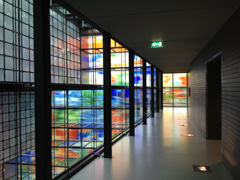“The future isn’t either traditional or digital: it’s a feedback loop between the two. Television fans want to get involved and be counted. It’s how creative we are in engaging those fans – and keeping them connected even as they may move away from the traditional network – that will determine how potent and profitable we will be in the future.”
– Kevin Reilly, President of Entertainment, Fox Broadcasting (as quoted by Mainwaring, 2012)
 The 6th biennial seminar in the “Changing Sceneries Changing Roles” series offered by the Media Management Commission of FIAT/IFTA was hosted at the Netherlands Institute for Sound and Vision (Beeld en Geluid) in Hilversum on May 16th and 17th of 2013. The theme of “Metadata as the Cornerstone of Digital Archiving” was destined to be popular. Indeed, attendance was strong, with the conference attracting over 175 people from as far away as Brazil, Japan and Qatar. The attendees were predominantly archivists, but also computer scientists and educators. However, the topics discussed were and continue to be relevant to all those who work with audiovisual media. The subjects included Linked Metadata, Preservation metadata, Automatically Generated Metadata, and User Generated Metadata.
The 6th biennial seminar in the “Changing Sceneries Changing Roles” series offered by the Media Management Commission of FIAT/IFTA was hosted at the Netherlands Institute for Sound and Vision (Beeld en Geluid) in Hilversum on May 16th and 17th of 2013. The theme of “Metadata as the Cornerstone of Digital Archiving” was destined to be popular. Indeed, attendance was strong, with the conference attracting over 175 people from as far away as Brazil, Japan and Qatar. The attendees were predominantly archivists, but also computer scientists and educators. However, the topics discussed were and continue to be relevant to all those who work with audiovisual media. The subjects included Linked Metadata, Preservation metadata, Automatically Generated Metadata, and User Generated Metadata.
With the proliferation of digital media in both the private and public arenas, a great tide of digital content is upon us, one that requires careful management and preservation. Without early intervention, valuable digital assets may be lost. It is common knowledge that benign neglect (i.e., the strategy of shelving a book for a long period) is not a valid strategy for digital resources; this plan eventually places digital media at risk of technological obsolescence. Much effort has gone into developing realistic strategies to combat this risk, including emulation and migration. Metadata supports these strategies by explicitly describing the context, content, structure, and management of an object to ensure its access over the long term. While previous FIAT/IFTA seminars have focused on archivists’ changing roles, it’s refreshing to see they too recognize the importance of Metadata in multimedia preservation, so much so that they have devoted an entire seminar to the subject.
Foremost among the seminar’s trending subjects was the issue of how to bridge the gap between archivists and Information Technology (IT) staff. Many participants were concerned over the cultural differences between the two groups; IT is known to embrace pioneering technology while archivists are reputated for relying on tried-and-tested tools for solving problems. Florian Delabie (RTBF) embodied one possible answer to this concern, being both skilled in IT and media archiving. During the seminar, Delabie asserted the important role of the archivist in ensuring quality metadata while claiming that early user adoption is far more likely when IT involve archivists at an early stage and demonstrate the benefits of new application software. Although Beth Delaney (audiovisual collection management consultant) and Sandra Collins (Digital Repository of Ireland) agreed that communication between these groups is vital, Collins claimed they must jointly set goals and responsibilities at the beginning of a project. Many of the presentations raised the pertinent question of who should be responsible for metadata input. The various approaches presented (automated, user-produced, and semantically linked) are testament to the degree of thought the field is giving to this issue. The proceedings also demonstrate that the archivist’s role is much more intricate than simply managing media. It continues to be about preserving at-risk digital assets while ensuring they continue to be accessible into the future.

Jan Müller, president of FIAT/IFTA and head of the Institute for Sound and Vision, opened by welcoming the attendees to “metadata heaven”. In response to the momentum of Linked/Social TV, Müller surmised that all television would soon be interactive, shared, and created by amateurs. The key to collecting and managing this material, he argued, is metadata. Next, Seth van Hooland (Digital Information Chair, Information and Communication Science department of the Université Libre de Bruxelles) offered a comprehensive keynote about LinkedData, in which he argued for ‘clean’ RDF (Resource Descriptive Framework)-structured metadata, but cautioned archivists against sharing this metadata with the public unless practitioners intend to maintain it for the long term.
Video distribution must change in response to the way its users behave. To meet this challenge, Rutger Verhoeven (VARA) and Maarten de Rijke (University of Amsterdam) guided the audience on a tour of the Social Video Live Player, a LinkedTV player that suggests related programs for viewers to watch after analyzing program subtitles, generating keywords and linking them, by means of the semantic web, to similar content on the web. Xavier Jacques-Jourion (RTBF) walked us through a semantic based multimedia browser called GEMS, currently under development. As with the Social Video Live Player, GEMS extracts conceptual terms from the program audio and maps them to the semantic web using automated tools. This unique tool maps spoken terms to broader and narrower concepts, allowing multiple paths to discovery. During the question period, audience members asked whether the solution would scale with large amounts of content. Jacques-Jourion posited that tailoring the number of conceptual terms to the user would help match users to the content they desire. While Jacques-Jourion’s presentation may have been aimed at garnering potential buyers, the tool remains an impressive proof of concept.
During the first panel discussion of the day, Seth van Hooland stated that the Linked Metadata ecology is in an extremely fragile state; methods have yet to be developed to ingest and preserve Linked Metadata. Therese Nilsson (SVT) explained that while the Swedish public service television company’s user tags usually developed into folksonomies, the broadcast station’s journalists vet terms so that some measure of control is imposed on the user-generated vocabulary. Jennifer Wilson (BBC Scotland) argued that archivist-generated metadata should be enriched with Linked Metadata, but acknowledged that the needs of archivists and users are not always aligned. Seth van Hooland added that archivist metadata and Linked MetaData should be kept separate; the way information is presented to users should be up to the interface designer. Brid Dooley (RTÉ) offered that linking cultural heritage metadata from different institutions may be a worthwhile endeavor.
Karin Bredenberg (National Archives of Sweden) gave a keynote about preservation metadata, offering attendees a broad description of the PREMIS (Preservation Metadata: Implementation Strategies) guidelines and the OAIS (Open Archival Information System) reference model. Summarizing these complex frameworks is difficult, but Bredenberg’s presentation was generally successful; she used the metaphor of food storage in a refrigerator to describe the OAIS concepts of SIP (Submission Information Package), AIP (Archival Information Package), and DIP (Dissemination Information Packet). Concluding with a brief description of areas that merit further research, Bredenberg conceded that the audiovisual domain is relatively new to the PREMIS group, but encouraged archivists in this field to implement the guidelines because it is a widely used standard in the digital preservation sector.
Hot on the heels of Bredenber’s keynote, Daniel Steinmeier (Beeld en Geluid) launched the second group of case studies by describing Sound and Vision’s work to become a Trusted Digital Repository, an international certification based on the OAIS reference model that has yet to find an official independent body to perform an audit. His presentation concluded with several lessons learned from the experience so far: involve other staff in your organization, articulate staff roles and responsibilities, acknowledge that no single IT application can meet all of an archive’s functional requirements, conduct a risk assessment, and administer a cost/benefit analysis.
Kaisa Unander (National Library of Sweden) and Eva-Lis Green (SVT) co-presented a case study in which they discussed the strategy employed by the National Library to comply with new federal legislation that obligates it to archive web content from national media syndicates (i.e. newspapers, broadcasters). Unander and Green explained that the ‘designated community’ was unspecified in the legislation, making the development of preservation plans more challenging than it would have otherwise been. SVT adopted an option strategy (see Blue Ribbon Task Force Report) to preserve the digital objects until further work can be done to define the intended future users.
In the day’s second panel discussion, speakers tackled the question of establishing what constitutes sufficient metadata capture. Elena Brodie Kusa (FIAT/IFTA MMC) proposed mapping existing metadata to the set of PREMIS elements to determine the completeness of existing metadata. The issue of bridging the gap between IT and archive departments arose again, and there seemed to be a consensus that collaboration is essential and must be supported by management. Sandra Collins echoed an earlier statement made by Steinmeier that both groups must first define their goals and efforts at the beginning of any collaborative effort. While archivists were well represented in the conference program, computer scientists comprised less than a quarter of the total participants.
References
Mainwaring, S. (2012, October 1). Why Social Media Is Critical To The Future Of TV. Business 2 Community. Retrieved December 1, 2012, from http://www.business2community.com/social-media/why-social-media-is-critical-to-the-future-of-tv-0295942





Leave a comment